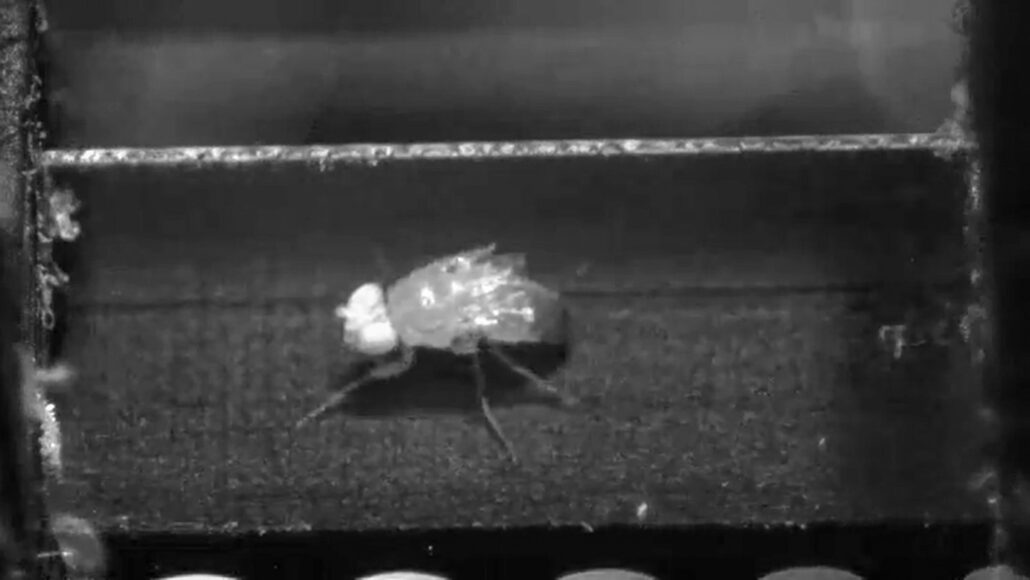Tiny treadmills reveal how fruit flies sprint
The critters broke a ground-speed record for their species, but would not go backwards

This tiny treadmill is made of simple belts, pulleys and motors and is covered with a nonstick enclosure. The machine allows scientists to study fruit flies as they walk normally.
The runner on the treadmill at the University of Washington wasn’t your typical gym rat. For one thing, he kept sprinting to the front of the treadmill and riding it to the back. For another, he had six legs.
The Seattle athlete was a fruit fly — officially known as Drosophila melanogaster. And for the first time, high-speed cameras watched him and other flies work out on the tiny treadmill. The videos have just revealed insights into how fly bodies move.
It creates a great opportunity to study how the fly brain controls different aspects of walking, says Eugenia Chiappe. This neuroscientist works at the Champalimaud Foundation in Lisbon, Portugal. She did not take part in the new work. But it’s important, she adds, to understand how brains of these — and other animals — pull this off.
Do you have a science question? We can help!
Submit your question here, and we might answer it an upcoming issue of Science News Explores
Fruit flies and humans look very different. Yet their brains are similar in many ways. So studying the flies could help researchers work out the basic biology of movement. “Our interaction with the environment, other animals and fellow human beings [is] crucial for our survival,” Chiappe says. And those interactions depend “depend on the ability of the brain to monitor and control movement.”
Researchers fashioned their mini treadmill out of simple and easy-to-get belts, pulleys and motors. Its overall length spans just over four times the body length of a fruit fly — about 2 millimeters (0.08 inch). To prevent the critters from flying away, researchers trimmed the flies’ wings. A glass chamber coated with slippery Rain-X surrounded the treadmill. It limited the flies’ ability to wall-walk. When the treadmill was on, the only floor available was a moving one.
On the treadmill, the flies moved as they normally do. Most of the time, they quickly ran to the front of the treadmill. Then they stopped and rode its traveling belt back to the end. As their abdomens then nicked the back of the chamber, the startled flies sprinted forward again.
“They sprint and then stop, sprint and then stop,” says Brandon Pratt, a neural engineer on the Seattle team.
Tippy-tarsi
The flies easily hit speeds of 50 millimeters (just under two inches) per second. That’s the “fastest speed ever reported” for Drosophila moving on the ground, Pratt says. He’s confident the flies can go even faster (though the researchers didn’t thoroughly test this).
Some of these flies proved to be marathon-level athletes, easily handling treadmill sessions pushing 90 minutes. Pratt’s team posted its results to bioRxiv.org on February 24.
As the flies ran faster, their bodies moved higher. They rose up on their tiptoes, or “tippy-tarsi,” as Pratt says. He’s referring to flies’ leg parts that move somewhat like human feet.
The flies treadmills could be modified to have two different belts. These treadmills could force each side of the insect’s body to move at a different speed. The flies’ middle legs compensated for this odd arrangement, the tests showed. The flies adjust their step distances to keep moving straight ahead. This change in stepping is akin to how a fly might handle a sudden gust of wind from one side. They would turn into the wind by changing the stride on the opposite side.
One thing the flies wouldn’t do: Run backwards. “They like to run upriver,” Pratt says.
The treadmill doesn’t allow scientists to record what’s going on in the flies’ brains as they move. That would be a valuable bit of data, Chiappe says. It could show how brain cells spring into action as the flies walk, run or adjust their stride.
Other test systems allow more detailed glimpses into the brain of a moving fly. This includes spheres on which tethered flies can walk. But those systems don’t allow the fly to move as naturally as the Seattle team’s treadmill does.
In addition to producing insights on movement, the treadmill experiments sparked some friendly competition, Pratt says. “There was a point where we were like, ‘Can we find the most athletic fly?’ We started going down a rabbit hole,” he says. “We even did a side project where we did endurance training in flies. It got a little ridiculous.”







